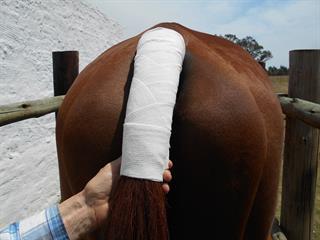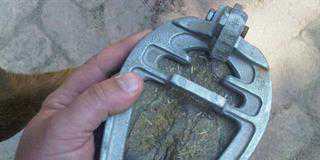
The herringbone tail bandage is often used by professional riders. It has several applications. It can be used to prevent a horse from rubbing its tail hairs off on the crossbar in a float. It will keep the horse’s tail clean in muddy conditions. It will help to keep a plaited tail tidy at a show. And it is often used when mating mares, especially during live covering.
Although effective, the bandage has to be applied correctly. The herringbone pattern prevents excess pressure on the blood vessels in the dock of the tail, but, if attached too tightly, it can lead to damage or even loss of the tail.
To put a tail bandage on properly, follow these steps:
- Before you begin: Obtain a 4m-long, 50mm-wide crepe bandage. Dampen the tail hairs on the root of the tail to ensure the bandage stays in place. Stand directly behind the horse and put the tail over your shoulder. If you are scared of being kicked, do this over a stable door or in a crushpen.
- Step 1: Moving left to right, slip approximately 30cm of the bandage under the tail. Ensure that about 10cm is turned up on the left side of the tail and held down above the root of the tail.
- Step 2: Wrap the bandage once around the root of the tail, then fold the end down onto the bandage. Secure it by wrapping the bandage around the tail again.
- Step 3: Holding the bandage at an angle, wrap it downwards to the left, loop it under the tail, and angle it up again to the right, so it crosses over the previous bandage by 2cm to 3cm.
- Step 4: Angle down to the left, under the tail and up to the right, once again overlapping by 2cm to 3cm.
- Step 5: Repeat until you reach the end of the tailbone.
- Step 6: Complete with two horizontal wraps, and secure the bandage with Elastoplast if the bandage does not have ties sewn on the end.
Removal
To remove, undo the tapes and pull back slowly and firmly towards the end of the tail. The bandage slips off like a tube, without being unwrapped.
Alternatives
If you are not yet expert enough to do a tail bandage properly, use a Velcro-fastened neoprene tail guard when travelling. This is much less likely to damage the tail. Some horse blankets have a flap covering the tail and this is more comfortable for the horse than a tail guard, provided the weather is not too hot. You can also use Velcro to fasten a tail bag onto the back of a travelling rug.
Don’t overdo it!
Ensure that the bandage does not stay on for longer than two or three hours. If it is very tight, even this may be too long; the main vein and artery can be closed off, resulting in gangrene. The pain is often intense and horses can look as though they
are suffering from colic.
Once the bandage has been removed, the tail will be bruised and swollen. The horse must be treated with anti-inflammatories and antibiotics. As the tail heals, pieces of skin, or even the whole tail may fall off. Often the hair does not regrow and the show career of the horse is ended.
For more information, click here.













